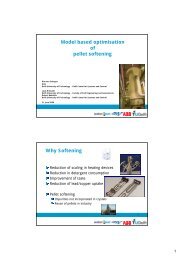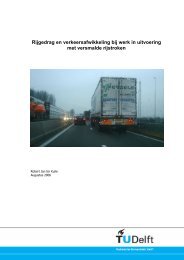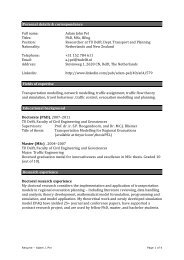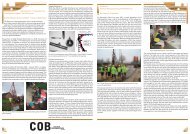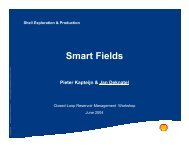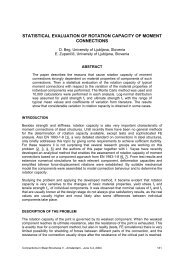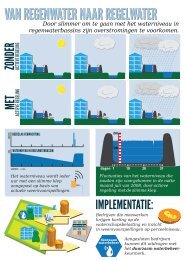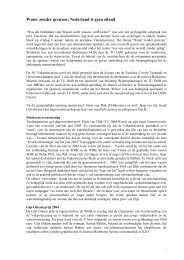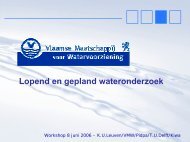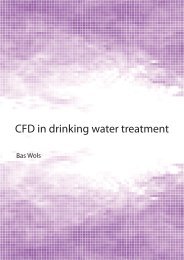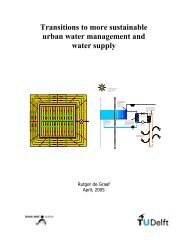Gertjan Medema Quantitative Microbial Risk Assessment ... - TU Delft
Gertjan Medema Quantitative Microbial Risk Assessment ... - TU Delft
Gertjan Medema Quantitative Microbial Risk Assessment ... - TU Delft
- No tags were found...
Create successful ePaper yourself
Turn your PDF publications into a flip-book with our unique Google optimized e-Paper software.
OutlineWhat is QMRA?QMRA frameworkCase studyRelation QMRA – risk management2
<strong>Quantitative</strong> <strong>Microbial</strong> <strong>Risk</strong> <strong>Assessment</strong>3
<strong>Quantitative</strong> <strong>Microbial</strong> <strong>Risk</strong> <strong>Assessment</strong>4
<strong>Quantitative</strong> <strong>Microbial</strong> <strong>Risk</strong> <strong>Assessment</strong>Probability of hazardous event x adverse effect of event5
<strong>Quantitative</strong> <strong>Microbial</strong> <strong>Risk</strong> <strong>Assessment</strong>Probability of hazardous event x adverse effect of event6
<strong>Risk</strong> assessment7
<strong>Risk</strong> assessment8
<strong>Quantitative</strong> <strong>Microbial</strong> <strong>Risk</strong><strong>Assessment</strong>Probability of hazardous event x adverse effect ofevent9
<strong>Quantitative</strong> <strong>Microbial</strong> <strong>Risk</strong> <strong>Assessment</strong>Probability of hazardous event x adverse effect of event10
<strong>Quantitative</strong> risk assessment11
<strong>Quantitative</strong> <strong>Microbial</strong> <strong>Risk</strong> <strong>Assessment</strong>Probability of exposure to pathogens x health effect of exposure12
OutlineWhat is QMRA?QMRA frameworkCase studyRelation QMRA – risk management13
ILSI Framework for QMRA14
ILSI QMRA FrameworkProblem formulationAnalysis• Exposureassessment• Effect assessment<strong>Risk</strong> characterization15
ILSI QMRA FrameworkProblem formulationAnalysis• Exposureassessment• Effect assessment<strong>Risk</strong> characterization16
Problem formulationInteraction risk manager – risk assesserDefine the purpose of the QMRADefine the breadth of the QMRAExplore the context of the QMRADevelop a conceptual model• Route(s) of exposure for QMRA• System under evaluation• Pathogens (characteristics)• Exposed population; immunity• Health outcome• Data needs• Preliminar, exploratory assessmentIncorporate control alternatives (optional)17
ILSI QMRA FrameworkProblem formulationAnalysis• Exposureassessment• Effect assessment<strong>Risk</strong> characterization18
Analysis - Exposure assessmentPathogen characterisation (relevant for exposure)• Die-off rate• Removal rate• Inactivation rate• Growth ratesPathogen occurrence• Frequency• Concentrations• Seasonality• Methodological issuesPathogen behaviour in system• Removal/inactivation• System variability19
Analysis - Exposure assessment 2Exposure analysis• Calculation of pathogen concentration in matrix• Consumption data• Combination of all information into exposuredata• Include variability (ranges, probabilistic)• Include uncertainty analysis• Include sensitivity analyis20
Analysis – Effect assessmentHost characterization• Age, pregnancy, immune-status, nutritional status etc.Human health effects• Duration• Severity (morbidity, mortality, sequellae)• Secondary transmissionDose response• Human (or animal) dose-response data• Type of response: infection, morbidity, mortality, DALY’s• Inoculum used (type, preparation, administration)• Study population characteristics• Strain variation• Statistical model21
Analysis – Effect assessment 2Host pathogen profile• Include variability• Include sensitivity analysis22
ILSI QMRA FrameworkProblem formulationAnalysis• Exposureassessment• Effect assessment<strong>Risk</strong> characterization23
<strong>Risk</strong> characterization<strong>Risk</strong> characterization• Combine data from exposure assessment and effectassessment into characterization of risk• Include variability (probabilistic)• Discuss assumptions: include sensitivity analysis• Discuss how outcome answers problem formulation• (Compare control scenario’s)• Identify data needs/improvements24
QMRA is iterative proces25
OutlineWhat is QMRA?QMRA frameworkCase studyRelation QMRA – risk management26
Case studySetting priorities for risk management<strong>Risk</strong> assessment by J.F. Loret27
Problem formulationSuez Environnement operates >1700 water systems in France. After thewaterborne outbreaks of cryptosporidiosis reported in the USA and UK, Suezwanted to develop an approach to evaluate the risk of Cryptosporidium for eachwater system. Such an approach would allow Suez to:• demonstrate compliance with the EU drinking water directive;• know if any of these systems was at risk to Cryptosporidium;• prioritise investments (if needed).Specific risk assessment goalWhat is the risk of Cryptosporidium in the (>1700) water systems?28
Hazard identificationCryptosporidium• absence of specific therapy• resistance to chemical disinfection.Questionnaire operators of each system• volume of water produced,• the type of source water used, including information on the type ofenvironment (urban, rural, presence of cattle etc.)• and data on general water quality parameters (coliforms, turbidity,ammonium and nitrate), and about the type of treatment processes.• The returned information covered treatment facilities that supply 9 millionpeople with drinking water.29
Exposure assessmentCryptosporidium occurrence in source water (data)30
Exposure assessment 2Cryptosporidium occurrence in source water (classes)31
Exposure assessment 3Cryptosporidium removal by water treatment (literature data)32
Effect assessmentDose response data and model (literature)33
<strong>Risk</strong> characterization34
<strong>Risk</strong> managementSystems at risk: small (
Case study 2:Water reuse guidelines Australia36
Problem formulationWater reuse guidelines AustraliaSemi-arid to aridIncreasing water demandWater recycling in crop and landscape irrigation,gardeningWater recycling in dual water systems for toiletflushing, laundrySpecific risk assessment questionIs a wastewater recycling system able to meetthe health-based target of 10 -6 DALY / y?37
Hazard identificationWater reuse guidelines AustraliaWastewater may contain a wide range of pathogensQMRA for each is not feasibleSelection of reference pathogens• Parasites: Cryptosporidium (small, resistant, infectious)• Viruses: Adenovirus/Rotavirus (infectious, available data)• Bacteria: Campylobacter (very prevalent, infectious)38
<strong>Risk</strong> assessmentWater reuse guidelines Australia[Pathogen]wastewaterApplicationSystem performancerequirementsHealth target39
<strong>Risk</strong> assessmentWater reuse guidelines Australia[Campylobacter]Wastewater7000/LApplicationSystem performancerequirementsHealth target
<strong>Risk</strong> assessmentWater reuse guidelines Australia[Campylobacter]Wastewater7000/LApplicationSystem performancerequirementsAnnual dose
Exposure assessmentWater reuse guidelines AustraliaConcentration of reference pathogens in wastewaterExposure through various applications42
<strong>Risk</strong> assessmentWater reuse guidelines Australia[Campylobacter]Wastewater7000/LApplicationSystem performancerequirementsAnnual dose
<strong>Risk</strong> assessmentWater reuse guidelines Australia[Campylobacter]Wastewater7000/LCommercial crop irrigationSystem performancerequirements5.0 logAnnual dose
Conclusions from case study 2Water reuse guidelines AustraliaQMRA used in wastewater reuse guidelines in aridregion….… to set performance targets for reuse systems… that are application specific… based on a predefined health target… using exposure data from scientific literature45
OutlineWhat is QMRA?QMRA frameworkCase studyRelation QMRA – risk management46
Relation with risk managementHEALTHTARGETSAcceptablerisk<strong>Risk</strong>ManagementAssessEnvironmentalExposure<strong>Assessment</strong>of riskPUBLICHEALTHSTA<strong>TU</strong>SFrom: Fewtrell & Bartram, 2001. in Water Quality Guidelines, Standards and Health (WHO). IWA publishing.47
<strong>Risk</strong> managementHACCP / Water safety planAssemble teamHEALTHTARGETReviewingexperience,future needsSystemassessmentDescribe water supplyConduct hazard analysisIdentify Control MeasuresOperationalmonitoringDefine Operational LimitsEstablish monitoringSupportingprogrammes<strong>Assessment</strong>of<strong>Risk</strong>Review,Approvaland AuditManagement &communicationEstablish corrective actionsEstablish record keepingEstablish validation + verificationPUBLICHEALTHSTA<strong>TU</strong>S48
<strong>Risk</strong> management questions that need quantitative answers<strong>Risk</strong> management questions thatneed quantification:Assemble teamSystemassessmentDescribe water supplyConduct hazard analysisWhat is my health target?What are the priority hazards?What is the significance of hazardousevents?Identify Control MeasuresIs my overall treatment adequate toproduce drinking water that meets thehealth target?OperationalmonitoringDefine Operational LimitsEstablish monitoringWhat are appropriate critical limits?How much monitoring is necessary?Management &communicationEstablish corrective actionsEstablish record keepingEstablish validation + verificationWhat level of corrective actions isneeded?49
<strong>Risk</strong> management: balancing the risksExpert judgement<strong>Risk</strong> 1 <strong>Risk</strong> 250
<strong>Risk</strong> management:balance between consumer safety and (consumer)cost.Expert judgementSafetyCosts51
<strong>Risk</strong> management:balance between consumer safety and (consumer)cost.QMRASafetyQMRACosts52
The value of <strong>Quantitative</strong> <strong>Risk</strong> <strong>Assessment</strong>The Commission needs to find the balance betweenthe freedom and rights of individuals, industry andorganisations with the need to reduce the risk ofadverse effects to human health and the environment.This balance should be:• science-based,• proportionate,• non-discriminatory,• transparent,• coherent and• requires a structured decision-making process withdetailed scientific, objective information within anoverall framework of risk analysis.Address by D. Byrne (Commissioner for Health & Consumer Safety) on the PrecautionaryPrinciple in the domain of human health and food safety. The Economist conference, Nov. 9,2000, Paris.QMRA53
Take home messages54
Framework for QMRAHelp the risk managerDefine goal and scope carefully, together with risk manager(s)Good QMRA Practice• Tracebility of data• Include variability (also include the odd peak event)• Describe and test assumptions (sensitivity analysis)Present outcome to risk managerYou are not the risk manager55
QMRA is iterative proces56
Relation with risk managementThere is so much uncertainty….HEALTHTARGETSZero uncertainty does not existAcceptableriskThe uncertainty is there, QMRA makes it visible<strong>Risk</strong>ManagementAssessEnvironmentalExposure• Weak spots → research program<strong>Assessment</strong>of risk<strong>Risk</strong> management has learned to deal withuncertaintyPUBLICHEALTHSTA<strong>TU</strong>SFrom: Fewtrell & Bartram, 2001. in Water Quality Guidelines, Standards and Health (WHO). IWA publishing.57



